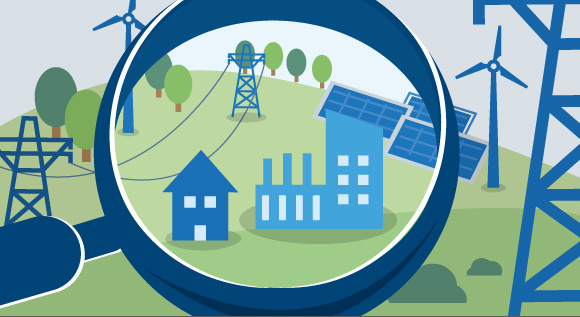What actually are carbon contracts for difference?
Carbon contracts for difference can help to make energy-intensive sectors more climate-friendly. Who promises what to whom in a carbon contract for difference? Come this way to find out more!
 © BMWi
© BMWi
This is what it's all about: sectors and companies receive grants towards operating and investment costs for the use of low-carbon technologies. These take account of their additional carbon-avoidance costs.
Like every good contract, a carbon contract for difference is about making and keeping a mutual promise. If all goes well, both sides benefit. In this case, the benefits are on a grand scale: for our climate and the future of our industrial firms. Sounds as though we’re exaggerating? Germany’s manufacturing industry employs around seven million people, and roughly 15% of them work in energy-intensive sectors. The latter are responsible for a fifth of the country’s greenhouse-gas emissions. In the time up to 2050, the sector is to be made entirely greenhouse-gas-neutral. For this reason, the Federal Government has drafted both the Hydrogen Strategy and the 'Steel Action Concept' for an internationally competitive and climate-neutral steel industry. After all, for energy-intensive sectors like steel and chemicals, the path to climate-friendly production is particularly challenging. They need a reliable basis on which to plan and a clear policy framework. Carbon contracts for difference can help here.
Origins in the financial sector
Contracts for difference hail from the financial world. They help to hedge against volatile prices, e.g. for shares or commodities. The seller and the buyer agree on a strike price for a certain product at a certain time. If the agreed price is below the market price at that time, the buyer has to pay the seller the difference between the agreed price and the market price. If the market price is higher than the strike price, the opposite happens: the seller has to pay the difference to the buyer. So this instrument is a good way of alleviating the risks of investing.
The mechanism can be used not only to hedge against uncertain price movements, but also to make new technologies competitive. Carbon contracts for difference (CCfDs) can for example be used to support greenhouse-gas-neutral manufacturing processes. These tend to be more expensive than the use of conventional technology, but are urgently needed in order to decarbonise the industrial sector.
How CCfDs work in practice
So what does this actually mean? Here’s a highly simplified example of two energy-intensive industrial companies: Company A uses conventional technology, has production costs of €10 for a product, and must additionally spend €5 on emission allowances for the carbon emissions generated in the production process. So the total production costs for the product are €15. As long as the carbon price is relatively low, the production using conventional technology in Company A is cheaper than in Company B, which uses a more expensive, greenhouse-gas-neutral technology and has production costs of €16. The carbon avoidance costs for Company B amount to €6. The state and Company B can now conclude a CCfD which offsets the difference between the market price for emission allowances and the carbon avoidance costs. In our example, this difference is one euro (six euros carbon avoidance costs minus five euros for the emission allowances). If the market price for emission allowances is lower than the carbon avoidance costs, the state pays the difference to Company B. If it is higher, Company B must pay the difference. In the case of energy-intensive industry, however, the avoidance costs are often far higher than the costs of emission allowances. In this case, CCfDs ensure that climate-friendly technologies can compete with conventional technologies. The advantage of a CCfD is that it takes account of a company’s actual avoidance costs and its possibilities to pass them on on the market. If, over time, changes arise in the price of emission allowances, for example, or in the field of EU measures to prevent carbon leakage, the difference payments can be adjusted flexibly.
A reliable basis for investment and incentives for carbon reduction targets
The Hydrogen Strategy adopted by the Federal Government in June 2020 envisages that CCfDs can be used by energy-intensive industrial companies in a pilot scheme. CCfDs give the companies a reliable basis on which to invest, coupled with incentives actually to attain the promised carbon reduction targets. They are therefore an important instrument to help climate-friendly industrial processes to reach market maturity and to break through on to the market. They can create stable demand for hydrogen and would thus have a positive impact on the supply side.
Further information
- Brochure by the Federal Ministry for Economic Affairs and Energy: 'The National Hydrogen Strategy'
- Publication by the Federal Ministry for Economic Affairs and Energy: 'Combatting climate change and boosting the economy'. Proposal for an alliance of society, business and government to promote climate neutrality and prosperity
- Brochure from the Federal Ministry for Economic Affairs and Energy: 'For a strong steel industry in Germany and Europe'

